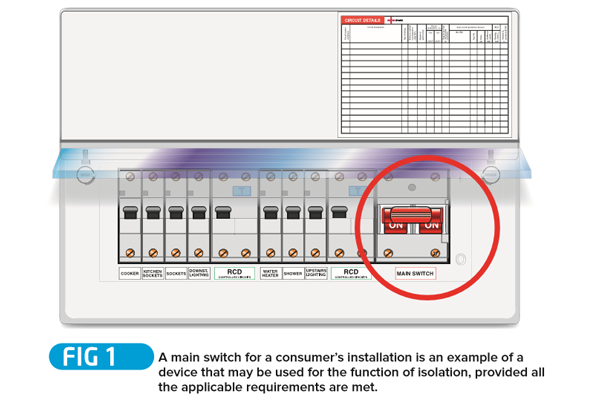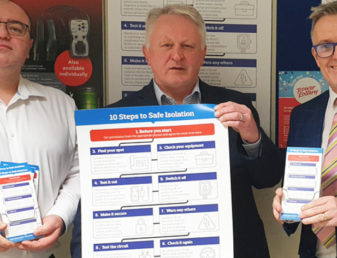This article from ELECSA provides a brief overview of isolation and switching how the terms are used in BS 7671.
The term ‘isolation and switching’, as used in BS 7671, embraces four distinct concepts, each with its own particular requirements for safety. The four concepts are:
- isolation,
- switching off for mechanical maintenance,
- emergency switching, and
- functional switching.
This article will only consider isolation.
Summary of the four safety concepts
Switching off for mechanical maintenance is used to enable non-electrical work to be carried out on the circuit or equipment safely, such as a boiler. Emergency switching is used to rapidly disconnect electrical energy to remove an unexpected hazard, such as a firefighter’s switch. Functional switching is used to enable the proper functioning and control of current-using equipment, such as a typical light switch.
Isolation
Isolation is used to enable electrically skilled or instructed persons to work safely on a circuit or equipment.
Definition of isolation
Isolation is defined in BS 7671 as:
“A function intended to cut off, for reasons of safety, the supply from all, or a discrete section, of the installation by separating the installation or section from every source of electrical energy.”
The corresponding definition in the Electricity at Work Regulations (EWR) 1989 (Regulation 12) further requires that isolation is to be carried out in such a way that the disconnection and separation of the electrical equipment from sources of electrical energy is secure.
BS 7671 does address this matter in certain of its Regulations, requiring provision be made for securing an isolating device against inadvertent or unintentional operation.
Purpose

The purpose of isolation is to enable work to be carried out on, or in the vicinity of, parts that are normally live in service, without risk of injury or death from:
• electric shock,
• electric burns, or
• burns due to arcing or flashover.
Electric burns, as explained in the Memorandum of Guidance on the Electricity at Work Regulations* are due to the heating effect caused by the passage of electric current through body tissues. They are most commonly associated with electric shock and often occur in and on the skin layers at the point of contact with the electrical conductors which gave rise to the electric shock. The meaning of ‘electric shock’ is generally understood, but it is worth briefly considering the two types of burn (electric burns and burns due to arcing or flashover).
Burns due to arcing, flashover or the vaporisation of metal can be caused to a person who is in the vicinity when a short-circuit or earth fault condition occurs on energised conductors. Such injuries can be sustained even where the conductors operate at extra-low voltage (as well as in higher voltage systems) if the available fault current is of sufficient magnitude.
Isolation is not primarily intended to protect persons from burns due to contact with hot parts of equipment (such as lamps); Switching off for mechanical maintenance would be more relevant to such a purpose.
Persons
Isolation is provided to protect a person engaged in electrical work, who is either a skilled person or an instructed person.
A skilled person is defined as a person who possesses, as appropriate to the nature of the electrical work to be undertaken, adequate education, training and practical skills, and who is able to perceive risks and avoid hazards which electricity can create and an instructed person is defined as a person adequately advised or supervised by skilled persons to enable him/her to perceive risks and to avoid hazards which electricity can create.
Have any questions? Post them in the comments below.
* The Memorandum of Guidance on the Electricity at Work Regulations is EWR published by the Health & Safety Executive
For other guidance and publications please see the ELECSA website. Information about the ELECSA Domestic Installers schemes, visit www.elecsa.co.uk







